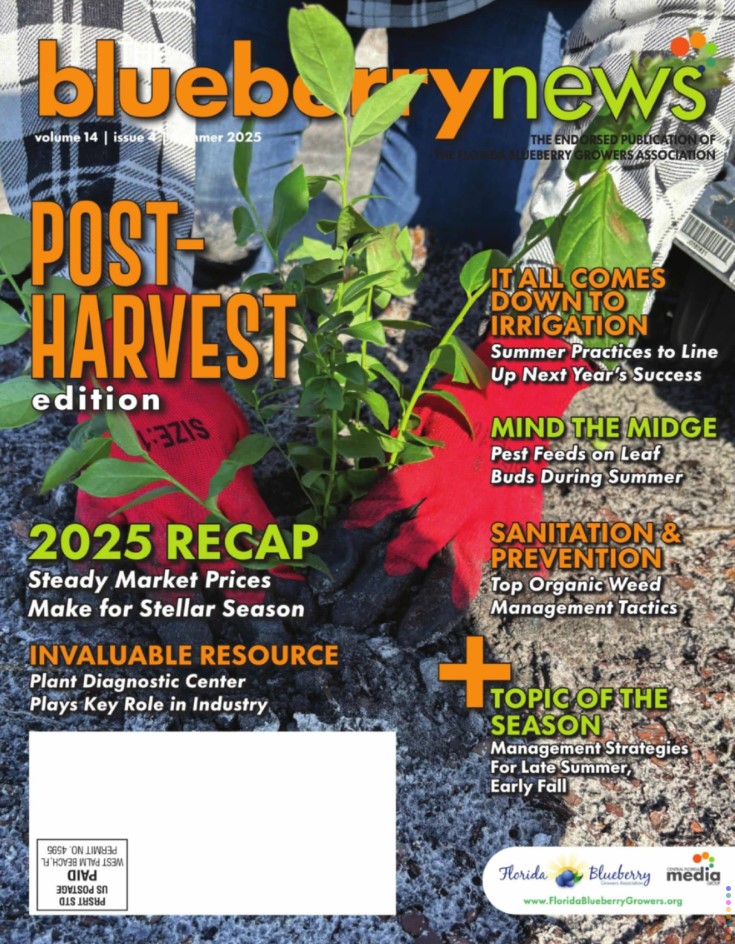Control Measures for Blueberry Gall Midge
Blueberry gall midge (BGM) is a longstanding and persistent pest of blueberries in Florida, especially in North-Central Florida and some areas of Central Florida. Adult BGM lay eggs in floral and vegetative buds as the scales begin to open, and the larvae feed on the developing tissue in the buds (Figure 1). With floral buds, this leads to damage, necrosis, and death of the buds, resulting in reduced yields. The injury from gall midge can appear as brown, dried-out buds that disintegrate and fall from the stems resulting in reduced bloom, and situations where only one or two florets emerge from a damaged floral bud instead of a more typical 5 or 6 florets. In vegetative buds, new emerging shoots and foliage are damaged and appear as black and distorted tissue.
Figure 1. BGM larvae feeding on blueberry floral buds.
Credits: O. Liburd, UF/IFAS
Effective BGM control involves monitoring, preventative sprays, and observation-based sprays. Monitoring for adults can be done using either bucket traps or clear sticky traps. Bucket traps have a sticky Plexiglas top, and are placed under bushes in direct contact with the bed to trap new adults emerging from the ground. It also catches BGM larvae that fall from the bush. The suggested placement density is 3–5 traps per acre. The sticky trap is a 12- or 6-inch square sheet of transparent plastic, attached to the bush and covered with a sticky adhesive spray. The Plexiglas top or the sticky sheet must then be viewed under magnification (at least 10x) to properly identify the adult BGM. Identification can be difficult, as other midge species that are not harmful to blueberries and are similar to BGM can appear on the surface of the Plexiglas. One of the key distinguishing characteristics of BGM is the antenna structure, which looks like a series of balls connected by sticks (Figure 2).
Figure 2. BGM antenna structure.
Credits: D. Phillips, UF/IFAS
Another monitoring method is to cut several stems with floral buds and place them in a zip-close bag at room temperature for a few days. If present, mature orange-colored larvae (Figure 3) will appear on the sides of the bag.
Figure 3. Mature BGM larvae.
Credits: O. Liburd, UF/IFAS
Many growers use preventative sprays for control of BGM, especially on farms with a history of this pest. The first application should be made right before floral bud break, with a second application made 10 days later. One potential management program is to use Apta® (Tolfenpyrad) or Exirel® (Cyantraniliprole) as a preventative spray in November when there is little activity in the field. A second application with Movento® (Spirotetramat) + Induce® (a non-ionic wetter/spreader surfactant) should be made when there is more midge pressure in the field in December or early January (if leaves are still on the blueberry bush). When floral bud scales begin to open, Delegate® (Spinetoram) can be used if the pesticide is allowed to dry for three hours before pollinators can forage. In cases where only leaf buds are present in the field, a second application with Movento® + Induce® may be warranted.
Credit: DR. OSCAR LIBURD, Professor and Program leader, Fruit and Vegetable Entomology, University of Florida,
& DOUG PHILLIPS, Blueberry Extension Coordinator, University of Florida





